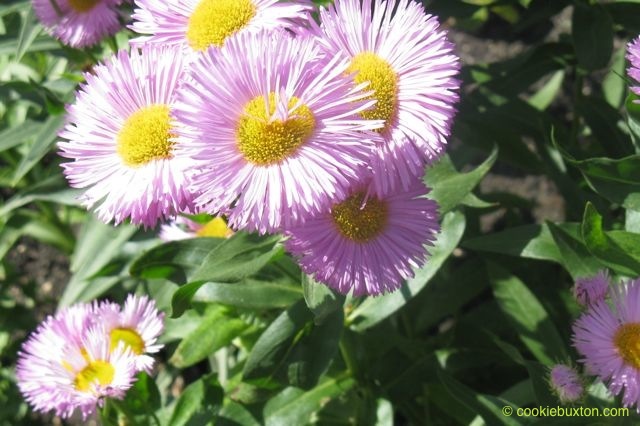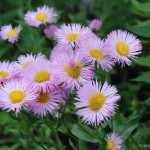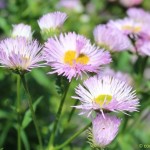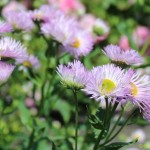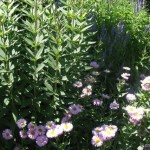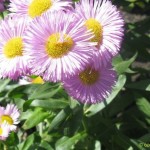Fabulous Fleabane
Fleabane.
Photo is probably of Erigeron speciosus.
Everything about the fabulous Fleabane flower is interesting, and even a little amusing. Named Fleabane to describe its herbal anti-insect properties, it is in fact in its live state highly attractive to a great variety of insects, though its oil contains flea-repelling properties valued by early settlers and modern herbalists. And, it is of the genus Erigeron, which, Wikipedia has noted, comes from Greek words meaning, Eri – for early and geron– for old man, referring to the production of white “hairs” produced once the plant has flowered.
The Fleabane in my yard is a legacy plant that I inherited from my mother’s garden, and there is no record of which species this is. Judging by the photographs in Lois Hole’s Perennial Favourites (1995), I believe my plant to be Erigeron speciosus (Daisy Fleabane). Although Fleabane can be an annual, biannual, or perennial, Erigeron speciosus is a perennial. My plants have been growing well in their present locations for over 17 years. The height of these lavender flowers, brightened by their bright yellow centres, is usually over 60 cm in height (2 feet tall). These plants are reliable and well behaved, which is to say, non-invasive. They can suffer from attacks of mildew, but I have not found this to be a problem. Gardeners can avoid this by following the advice of Ms Hole, who suggests watering at the base of these plants to help keep the foliage dry.
Prior to her death in 2005, Lois Hole wrote and published her Lois Hole seven-book “Favourites” gardening series. Her books, and those subsequently written by her son Jim Hole, remain on the popular reading list for Canadian and American gardeners.
Fleabane plants do well in the sun or in part-sunny locations. Ms Hole advises not to crowd the plants, and, in fact, that’s what has been happening to my plants in recent years as other tall plants grow around them. I can see that they are weakening a bit as a result of this encroachment on their territory and I need to fix this. When fertilizing, it is suggested that we do so lightly. Too many nutrients, Ms Hole advises in her “Perennial Favourites” book, create leggy plants that flop over.
My inclination, mainly because I garden in my spare time, is to simply leave the plants alone. They are long-lived perennials, and they come back beautifully each spring. They bloom in the same location each year and around the same time as peonies in my Zone 3 garden. They tend to last through the first blush of the rose season and stay in bloom roughly six to eight weeks, depending on whether or not we have a warm spring season. After they have finished blooming, I cut mine back to about medium height, and I find the foliage remains attractive and appears healthy for most of the growing season.
One of the rather delightful features of the Fleabane is the manner in which the little florets or “hairs” spring right out of eye of the plant, giving them an unusual appearance. The flowers look lovely in bouquets, and in a mass planting they create a dramatic effect.
In looking up how the plant got its name, I came across several conflicting articles, some saying there was no scientific proof of its flea-repelling qualities, and other articles confirming exactly those properties. It is probable that these properties depend upon which of the 390 species in the Erigeron family one has in mind. In reading about Erigeron canadensis, the common species that is abundant in prairie meadows, it is clear that the live flowers are highly attractive to insects. Its “bane” attributes or repellant features evidently come into play when the plants are smoked or when the plant’s oil is extracted from its flowers and applied as a repellant. Drying the flowers, it seems, does not render them useful as a “flea bane.”
Personally, I am grateful to have fabulous Fleabane growing in my yard. It is one of my personal garden favourites.
If you are interested in learning more about the herbal and medicinal properties of oil from Erigeron species, you might like the article on The Oil Shop website. Or, simply type in the species name on Google and browse through the numerous articles that you can access this way.
Photos and text: NK
Copyright: NK/cookiebuxton.com
Photo Gallery
Click on any photograph to enlarge, and click again on a photograph to advance through the series.
